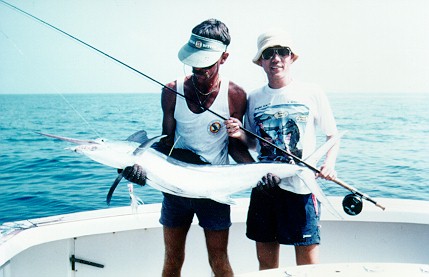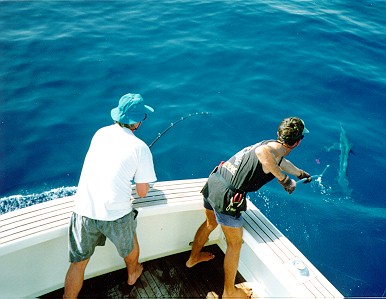Marlin on Fly
Black marlin on fly, Cape Bowling Green, Queensland

An edited version of this article appeared in (Australian) “Modern Fishing” magazine, April 1994, pp. 50-53.

It is hard to explain to the non-flyfisherman what we are actually trying to prove when we go saltwater flyfishing. The mechanics of casting, the long rods, the special flylines etc. seem to serve to make it as hard as possible to catch a given fish. The flyfisherman goes out fishing, gets outfished five to one by his mates using conventional gear, and goes away feeling superior. I don’t think I can explain why we do it, its just that when you catch a fish on a fly, the experience is so much more enjoyable.
One of my fishing ambitions was to catch a marlin on a fly. If saltwater flyfishing is an eccentric pursuit anyway, why not try to catch the most glamorous fish of them all?
To catch a marlin on a fly, there is only one place in Australia to go: Cape Bowling Green. These grounds, pioneered by Calvin Tilley, are arguably the world’s most prolific juvenile marlin waters, and 10 marlin a day is nothing unusual at Cape Bowling Green.
With the advice of Andrew Brzoz, proprietor of the Australian Fly Fisherman shop and the person who caught the first sailfish in Australia on a fly, we booked a 4 day charter on “Seaducer” through Angling Adventures. Andrew caught his sailfish from Seaducer and it was also the boat from which Jack Samson caught his black marlin which is described in his book, “Saltwater Fly Fishing”.
The trip was taken with my usual fishing mates, Ian Moore and Warren Monks. Ian was keen to flyfish whereas Warren would use conventional tackle.
After booking the trip, we had to organise our fly gear. We opted for Composite Developments 12-14 weight rods and Scientific Angler’s System II 12-13 reels. We were confident that the 12-13 reel would do the job, and it holds A LOT of line - about 400 yards of 30 lb backing, shooting line plus shooting head.
The fly of choice was a big white streamer with a tandem hook arrangement. We tied 8 of these on 4/0 hooks. These flies had a deerhair popping head and we prerigged them with a a 12 inch, 80lb Mason (hard type) shock tippet and a 10kg class tippet to form our fly/leader arrangement. We fished 10kg since it offered the advantage of being a new IGFA line class and not many record claims had been made. It also didn’t hurt to fish heavier leaders.
We finally got onboard Seaducer and met the captain, Calvin Tilley and deckhand Peter Reyne. It was a dark, windy day with a 1.5 meter swell. We reached Cape Bowling Green and started trolling deadbaits on conventional 6 kg tackle to get a feel for the fishing before we broke out the flyrods. This proved to be a pretty good formula and although we could have gone lighter, we did lose a few fish with broken lines etc.
The first thing we did was to stop on top of a bait school and get some livebait. Obtaining livies involved dropping a bait jig over the side, a couple of jerks, and winding in the jig, which by now would have a bait on each hook. In about five minutes, we had enough bait. The bait schools at Cape Bowling Green have to be seen to be believed. Some were about half a kilometer in diameter. Calvin said that they are sometimes kilometers in diameter!
In the first fifty meters of trolling, we had a hookup. Warren had no trouble landing it. It was a mack tuna. Warren was actually pretty happy with it, but Peter and Calvin looked at it in disgust, mumbling that it wasn’t a marlin.
By lunchtime, we had already caught 5 black marlin, all three of us having caught at least one. The marlin were about 50 to 70lb. In addition, we got two mack tuna and a spotted mackerel.
In the afternoon we started on fly. The procedure that we used was nearly exactly the same as that described in the Billy Pate video “Flyfishing for Billfish”. The marlin are teased up to the surface by trolling hookless teasers. On my first shot, the marlin actually took the fly, but I struck while it was still facing me and thus did not set the hook.
That evening, we practised casting by connecting a plastic milk bottle to the teaser rod and retrieving it as if it was a marlin. The person practising, would cast a fly to the “marlin” as it approached the boat. As we did this, a giant barracuda appeared from nowhere and smashed the milk bottle, completely crushing it. Warren, who was holding the rod, cast it out again and this time the barracuda took the milk bottle and raced away. For a few seconds he fought the barracuda until it finally let go of the milk bottle and swam away. As Calvin said, “There are so many fish out here you can catch them on milk bottles!”.
For the next four days, we tried and tried to get one on fly. We would troll at the unproductive times (and usually catch a few marlin) and then when the fish were on the bite (usually around the full tide), we would try the fly. We had about about sixteen shots up to the last afternoon of the charter and missed them all.
Some of the problems that we had were that the teasers were not cleared in time, we cast but the marlin didn’t seem interested in the fly, marlin ate the teaser etc. However, every shot was a new experience and every time was exciting. Imagine a fish about 50 to 80 lb charging up behind the boat to grab the teasers and then sight casting to it!
On the second day, Warren was fighting another mack tuna and suggested that I jump in the water and take some pictures of the fight from the water. Seconds after he finished this sentence, a huge blob appeared in the water. Warren pumped the fish in frantically, and the blob got bigger and bigger, and finally a huge whaler shark could be seen deep in the water. Dispite Warren’s efforts, the shark ate the estimated 25 lb tuna in one bite and disappeared.
Just after lunch on the last day, Peter suggested that we tie a different fly. The one that we were using wasn’t that visible and it was hard to smash it on the water with enough commotion that the marlin could hear the fly over the diesels and wake of the boat. We ended up tying the “mother” fly. I tied the fly with specifications given by Peter - “tie me the biggest ugliest fly you can”. To achieve this, I used half a pack of saddles on the rear hook and white, brown and grey deerhair on the front hook. The finished fly looked like a small bird and I had doubts as to what a marlin could possibly mistake it for. To this fly was added a big popping head which was white with pink candy strips and eyes. The resulting beast looked so ugly it had to work!
At about 2:30pm I saw a marlin come up on the teaser with its tail and dorsal fin sticking out of the water. “Marlin” I shouted and all of the crew rushed to bring in the other teasers. Peter teased the fish to about 30 ft from the back of the boat. “Are you ready?”, shouted Peter. “Ready”, I yelled and started my backcast as Calvin put the boat into neutral. I smashed the fly onto the water, in front of, and to the right of Mr Marlin. I gave it one twitch and the marlin turned and grabbed the fly. This was the perfect opportunity since the marlin was side on to me and I could set the hook into the side of the mouth. I struck once, twice, three times, then a fourth but nothing happened - the marlin must not have even felt it. Then, after hitting the fish five or six times, the marlin moved slowly away and I cleared my line. It accelerated, stripping off about 100 yards of line in a couple of seconds. It made the first of many jumps out at about 100 yards. After jumping a few more times, Calvin started backing the boat towards the fish and I wound frantically.
After a few more jumps, the marlin went down. Even on a game rod, if a marlin fights by going down deep, it can take half an hour to raise it. On a fly rod, it would be many times worse. Luckily, this marlin only went down about 40 feet and we could see it easily in the clear waters at Cape Bowling Green. I gradually fought it to the surface by continually changing the direction of pull. Calvin also positioned the boat to always be fighting the fish from a different angle. During the entire fight, Peter was giving me advice, and with their help, it gradually came to the surface.
My main problem at this stage was that my hands were covered with sweat and I was struggling to hold on to the rod, let alone fight the fish. I was holding the rod just under the first guide and pulling up as hard as I could. When the fish made a run or jump, the rod was quickly pointed at the fish so as to minimise the line tension. After about 15 minutes, the fish was about 8 foot from the back of the boat and Peter managed to tag it on the first attempt. Upon being tagged, the fish swam down again and it took another 5 minutes to bring it back up. It was brought to the side of the boat without too much drama and Peter grabbed it by the bill and lifted it onboard for a quick photo.
The fish was about 2.2 m and weighed an estimated 25 kg. After the photo, it was revived and then released. Congratulations were given all around and we had the whole afternoon to try to get one for Ian.
Ian had put on my “mother” fly and not long after, I heard Calvin shout “Fish”. Peter grabbed the teaser rod and Warren and I raced over and wound in the other teasers. In a few moments, I looked around and Ian was striking like a madman, the rod being loaded with a decent bend. The next second, the fish let go of the fly and it descended into the depths.
Unfortunately, although Ian had one final chance, it was not to be. I’m sure he will be back there to try again. In total, we caught 13 marlin and a sailfish, only one marlin falling to the fly. We had one double hookup with both fish landed. We did miss some greater than 70 lb black marlin on fly which we would have submitted for an IGFA 10 kg record claim, however, although this was always a possibility, we were not chasing records, but just trying to catch a marlin on fly.



